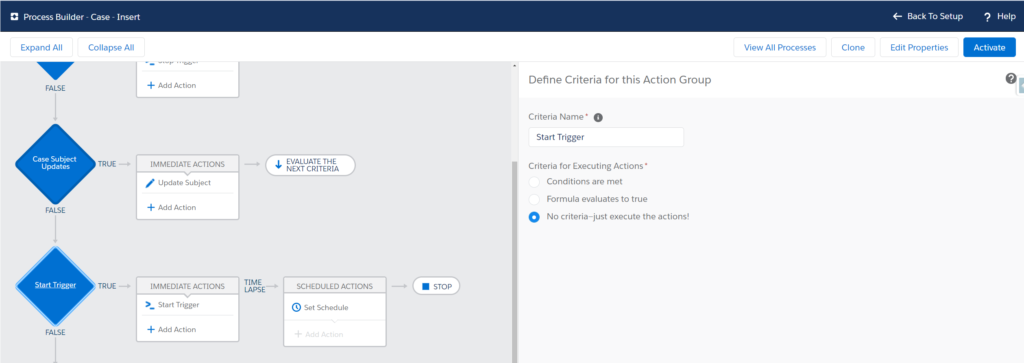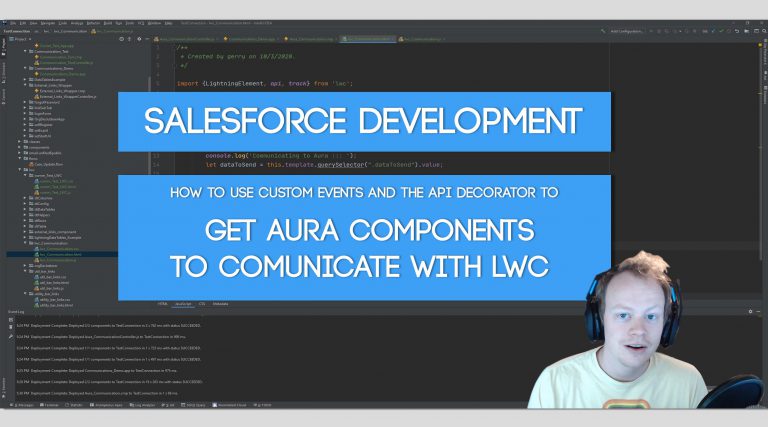Salesforce Development: How to Make Sure Your Process Builders Never Fire Your Apex Triggers
Why Would We Want Our Process Builders to Bypass Our Triggers?
If you didn’t know process builders fire your triggers every single time they make an update to a record or insert a new record. If you have 5 different update actions in your process builders that means you could potentially fire your triggers 5 times in the same process builder execution!! That would absolutely destroy your operation speeds, and if you didn’t know Process Builders are already know to be very poor performance wise (taking up to 40 times longer than flows or triggers to operate). That being said even process builders have their place, especially in admin heavy orgs. So let’s figure out how to make sure they are as performant as they can be.
As a side note: If your process builders rely on your trigger to re-run after they execute… you have a problem and you need to fix it. Process builders should never require a trigger to re-run after it executes.
SUPER IMPORTANT NOTE: Make sure to re-start your triggers at the end of your process builder. If you don’t you could have pretty horrible ramifications with the data loader and with Database all or none transactions. Don’t worry we go over how to restart them in your process builder as well.
Setting Up The Super Simple Apex Code To Make This Work
First things first. If you want the code and config for this , you can grab it here on github.
Now let’s get to it! Unfortunately we have to write a little apex code to make this magic work (or fortunately if you love code like me), but don’t worry! It’s very simple. The first this we’re going to make it a small utility class that allows us to pass in the name of a trigger we’d like to bypass.
//The utility class that allows us to determine which triggers we want to bypass
public with sharing class Util_Trigger_Name_Bypass
{
//The set of trigger names that we want to bypass in our trigger.
public static Set<String> bypassedTriggers = new Set<String>();
//Method that allows us to add a trigger that we want to bypass
public static void bypassTrigger(String triggerName)
{
bypassedTriggers.add(triggerName);
}
//Method that allows us to remove a trigger from our bypassed triggers set
public static void removeBypass(String triggerName)
{
bypassedTriggers.remove(triggerName);
}
}There is one major thing to note about the code above. We utilize the static keyword to declare our variable (and our methods too). If you are not familiar with the concept of static (or class) variables, you should definitely take the time to investigate them more, but I will briefly explain it here. Static variable persistent for your entire execution context. What this means is that our variable’s value will remain the same in the trigger and the process builder (and anything else after or inbetween). This is critical! If it wasn’t a static variable we wouldn’t be able to achieve this.
Now that we have this nice utility class that allows us to put the names of the triggers we would like to bypass. Let’s write a couple more small apex classes with invocable methods that our process builder can call to add the name(s) of our triggers we would like to bypass while our process builder is running.
//Class that you can call from a process builder that allows you to stop a trigger from executing
public with sharing class Util_PB_Trigger_Stop
{
//You can find this invocable apex method in your process builder when you look for
//the "StopTrigger" label in an apex action.
//This method adds trigger names to the utility we made that stores trigger names we
//would like to bypass.
@InvocableMethod(Label = 'StopTrigger' Description='Method allows up to bypass
triggers')
public static void stopTriggers(List<String> triggerNames)
{
Util_Trigger_Name_Bypass.bypassTrigger(triggerNames[0]);
}
}//Class that you can call from a process builder that allows you to start a trigger again
public with sharing class Util_PB_Trigger_Start
{
//You can find this invocable apex method in your process builder when you look for
//the "StartTrigger" label in an apex action.
//This method removes trigger names from the utility we made that stores trigger names
//we would like to bypass.
@InvocableMethod(Label = 'StartTrigger' Description='Method allows up to restart
triggers')
public static void startTriggers(List<String> triggerNames)
{
Util_Trigger_Name_Bypass.removeBypass(triggerNames[0]);
}
}As you can see the above apex classes just allow us to add or remove the names of our triggers we want to bypass to our utility class’s bypassedTriggers Set. Noice, very convenient and very simple. The last two things we need to do are update our trigger, so that it looks to our Util_Trigger_Name_Bypass utility class to determine if it should run and create our process builder!. Let’s take a look at the trigger.
//Our Case Trigger. Please use a trigger framework and never put logic in your triggers.
//I created this trigger in this way for demonstration purposes only and to
//simplify this lesson.
trigger Case_Trigger on Case (before update, before insert)
{
//Looking at our utility class to determine if we should run our trigger logic.
if(!Util_Trigger_Name_Bypass.bypassedTriggers.contains('Case_Trigger'))
{
Case_Trigger_Handler.beforeUpdate(trigger.new);
Case_Trigger_Handler.beforeInsert(trigger.new);
}
}As you can see from the above trigger, before we execute the logic for our trigger we first check to determine whether or not our utility class’s bypassedTriggers set contains the name of our case trigger. If it does, then we do not execute our logic.
Setting Up The Process Builder
You can setup your process builder to bypass your triggers in two different ways. You can have your process builder shut off the trigger before it runs any operations or you can have it shut off the trigger just within the immediate action blocks that actually update or insert records. I would personally suggest you just turn it off for the entire length of the process builder because it’s more performant that way, so that’s what I’m going to show you below. If you would rather do it the other way, the video linked above explains it in detail.




As you can see from the above pictures this is super simple! We just create two nodes, one to stop the trigger at the beginning of the process builder and one to re-start the trigger at the end of the process builder. Both of those nodes have apex actions within their immediate actions that call the StopTrigger and StartTrigger Invocable apex methods respectively and pass it the name of our trigger we want to disable (in our case the Case_Trigger). Then you place any update or insert actions between those two nodes and you’re good to go! No more trigger logic run while your process builders execute! Wooottttttttt!!!!!!!!! Enjoy that massive boost in process time. The only next steps you have are to eliminate your process builders entirely, lol, because they are just garbage.
SUPER IMPORTANT NOTE: Make sure to re-start your triggers at the end of your process builder. If you don’t you could have pretty horrible ramifications with the data loader and with Database all or none transactions.
Moderately Important Note: Make sure you “Evaluate Next Criteria” in the “Specify What Happens After Evaluating This Criteria” node.
Get Coding With The Force Merch!!
We now have a redbubble store setup so you can buy cool Coding With The Force merchandise! Please check it out! Every purchase goes to supporting the blog and YouTube channel.
Get Shirts Here!
Get Cups, Artwork, Coffee Cups, Bags, Masks and more here!
Check Out More Coding With The Force Stuff!
If you liked this post make sure to follow us on all our social media outlets to stay as up to date as possible with everything!
Youtube
Patreon
Github
Facebook
Twitter
Instagram
Salesforce Development Books I Recommend
Advanced Apex Programming
Salesforce Lightning Platform Enterprise Architecture
Mastering Salesforce DevOps





